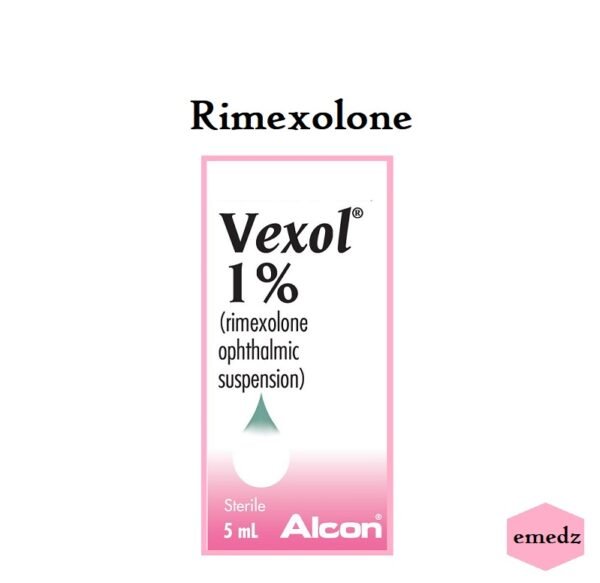Rimexolone is a corticosteroid medication used primarily in ophthalmology. It belongs to the class of corticosteroids known as glucocorticoids, which have anti-inflammatory and immunosuppressive properties. Rimexolone is often prescribed for the treatment of eye conditions such as inflammation and swelling following eye surgery, allergic conjunctivitis, and other inflammatory eye conditions. It works by reducing inflammation, swelling, and itching in the eyes.
Rimexel (Rimexolone) is used as a topical ophthalmic corticosteroid that inhibits inflammation associated with uveitis and ocular surgery.
Rimexolone Uses:
- Ophthalmic inflammatory conditions:
- It is indicated for the treatment of postoperative inflammation following ocular surgery.
- It is also used as an adjunctive treatment in patients with anterior uveitis.
Rimexel (Rimexolone) Dose in Adults
Note: Vexol has been discontinued in the United States for more than 1 year.
Rimexel (Rimexolone) Dose in the treatment of Anterior uveitis:
- In the first week: Put 1 to 2 drops into the eye every hour while you're awake.
- In the second week: Reduce the frequency to 1 drop every 2 hours while you're awake.
- After that: Gradually decrease the frequency until the uveitis is gone.
Rimexel (Rimexolone) Dose in the treatment of Postoperative ocular inflammation:
- Start 24 hours after surgery.
- Put 1 to 2 drops into the affected eye's conjunctival sac.
- Do this 4 times a day.
- Continue this schedule for the first 2 weeks after surgery.
Use in Children:
Not indicated.
Pregnancy Risk Factor C
- During pregnancy, Rimexolone is categorized as a Risk Factor C, meaning there have been adverse effects noted in animal studies when given through injection.
- However, when used as eye drops, the amount of Rimexolone absorbed into the bloodstream is minimal, ranging from less than 80 to 470 picograms per milliliter.
- This suggests that the risk of systemic effects on the fetus is likely low when Rimexolone is used topically in the eye.
Use during breastfeeding:
- It's unclear whether Rimexolone passes into breast milk, so caution is advised.
- Since serious adverse effects could occur in the nursing baby if Rimexolone is present in breast milk, the manufacturer suggests making a decision: either stop breastfeeding or stop taking the medication.
- This decision should consider the importance of the treatment to the mother's health.
Dose in Kidney Disease:
- The manufacturer's labeling for Rimexolone doesn't include specific dosage adjustments for individuals with renal impairment.
Dose in Liver disease:
- The manufacturer's labeling for Rimexolone does not include specific dosage adjustments for individuals with hepatic (liver) impairment.
Common Side Effects of Rimexel (Rimexolone):
- Central Nervous System:
- Foreign Body Sensation Of Eye
- Ophthalmic:
- Eye Discomfort
- Eye Pain
- Blurred Vision
- Eye Discharge
- Eye Pruritus
- Increased Intraocular Pressure
- Ocular Hyperemia
Less Common Side Effects of Rimexel (Rimexolone):
- Cardiovascular:
- Hypotension
- Central Nervous System:
- Headache
- Gastrointestinal:
- Dysgeusia
- Respiratory:
- Pharyngitis
- Rhinitis
Side effects with unknown frequency:
- Infection:
- Secondary Ocular Infection
- Ophthalmic:
- Cataract
- Eye Disease (Defects In Visual Activity)
- Eye Perforation
- Optic Nerve Damage
Contraindication to Rimexel (Rimexolone):
- Rimexolone should not be used in individuals who have a hypersensitivity to Rimexolone itself or any component of the formulation.
- Additionally, it's not suitable for those with acute untreated purulent ocular infections or viral diseases of the cornea and conjunctiva like herpes simplex keratitis, vaccinia, or varicella.
- Similarly, it's not recommended for mycobacterial or fungal eye infections.
- While documentation regarding cross-reactivity for corticosteroids is limited, due to similarities in chemical structure and pharmacologic actions, there might be a possibility of cross-sensitivity.
Warnings and precautions
Cataracts
- Long-term use of corticosteroids like Rimexolone can potentially lead to the development of posterior subcapsular cataracts.
- Additionally, when used after cataract surgery, corticosteroids may delay healing or increase the chances of bleb formation.
- It's essential for individuals using Rimexolone to be aware of these risks, and regular monitoring by an eye care professional is recommended, especially with prolonged use or after eye surgery.
Corneal thinning
- Corneal and scleral thinning can occur due to certain eye conditions and prolonged use of corticosteroids like Rimexolone.
- Continued use of corticosteroids in individuals with thinning of the cornea or sclera may increase the risk of perforation.
- It's crucial for individuals using Rimexolone to be aware of this potential risk, especially if they have existing corneal or scleral thinning.
- Regular monitoring by an eye care professional is important to detect any changes and prevent complications such as perforation.
Glaucoma:
- Prolonged use of corticosteroids like Rimexolone can lead to increased pressure inside the eye (intraocular pressure or IOP), potentially resulting in glaucoma.
- This elevation in IOP can cause damage to the optic nerve, leading to visual acuity and field of vision defects.
- It's important to exercise caution when using Rimexolone in patients with glaucoma and to monitor IOP regularly in anyone receiving treatment for 10 days or longer.
- If there are any signs of increased IOP or worsening of symptoms, medical attention should be sought promptly to prevent potential complications.
Immunosuppression:
- Prolonged use of corticosteroids like Rimexolone can suppress the immune system, which may lead to a higher risk of secondary infections, including fungal infections.
- Additionally, the use of corticosteroids can mask or worsen acute purulent ocular infections.
- In cases of persistent corneal ulceration after corticosteroid use, fungal infection should be considered and investigated.
Monitoring parameters:
Intraocular Pressure and Lens Examination
- Prolonged use of Rimexolone can raise pressure inside the eye.
- Regular checks of intraocular pressure (IOP) are necessary, especially for those using Rimexolone for 10 days or more.
- Examination of the lens should also be done periodically to monitor for any changes.
How to administer Rimexel (Rimexolone)?
Important Usage Instructions for Rimexolone Eye Drops
- Rimexolone is meant for use in the eyes only.
- To prevent contamination, avoid touching the dropper tip to your eyelids or any other surfaces when applying the drops.
- Shake the bottle well before each use to ensure proper mixing of the medication.
- It's not advisable to use the same bottle for both eyes, especially for surgical patients.
Mechanism of action of Rimexel (Rimexolone):
- Rimexolone works by suppressing the inflammatory response in the eyes.
- It achieves this by inhibiting various processes, including:
- Edema (fluid buildup)
- Capillary dilation (widening of blood vessels)
- Leukocyte migration (movement of white blood cells to the site of inflammation)
- Scar formation
- By targeting these processes, Rimexolone helps to reduce inflammation and associated symptoms in the eyes.
Absorption:
- Rimexolone is absorbed through the aqueous humor, the fluid in the front part of the eye.
Metabolism:
- Any amount of Rimexolone that gets absorbed undergoes hepatic metabolism, meaning it is processed by the liver.
Half-life elimination:
- Rimexolone has a relatively short half-life, lasting between 1 to 2 hours in the body.
Excretion:
- After metabolism, Rimexolone and its metabolites are primarily excreted through urine and feces, with more than 80% of the drug being eliminated through these routes.
International Brand Names of Rimexolone:
- Vexol
- Baxol
- Rimelon
- Rimexel
- Rixolon
- Vexolon
Rimexolone Brand Names in Pakistan:
No Brands Available in Pakistan.


 Injection for familial chylomicronemia syndrome.jpeg)

